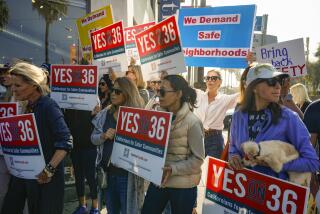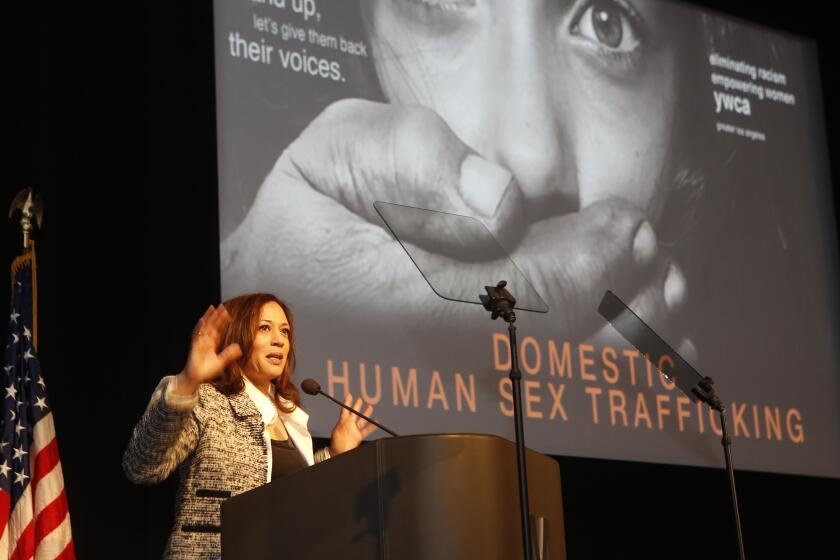The tobacco tax fight is different this time around, and the $100 million in funds raised is only part of it
Reporting from Sacramento — Never before have tobacco companies spent so much trying to defeat a cigarette tax hike in California. The $71 million raised by opponents of this year’s Proposition 56, which would add a $2 per pack tax on cigarettes, to date tops the industry’s totals in 2006 and 2012, when R.J. Reynolds and Philip Morris successfully knocked down previous tobacco tax hikes at the ballot.
But unlike those previous failed campaigns, proponents of this tobacco tax hike have done a lot more to match the industry’s dollars. The more than $32 million raised so far by the Yes on 56 campaign nearly doubles supporters’ prior highest total and narrows a once overwhelming spending gap. In both previous campaigns, the tobacco industry outspent supporters more than 4 to 1. Now, the tobacco companies’ margin is less than 2 ½ to 1.
“It’s more of a campaign among equals than in the past,” said Mark Baldassare, president and CEO of the Public Policy Institute of California, which has tracked public opinion on tobacco for years.
While money is a key element in every election, it’s proven especially so in tobacco tax campaigns. For a decade, opinion polls have consistently shown wide approval among Californians for the idea of raising cigarette taxes. But once opposition campaigns hammered away through television and radio advertisements and mailers about the details of the specific measures, the particular initiatives lost support and narrowly failed on election day.
Supporters of Proposition 56 have the same worries. Last month, a Yes on 56 campaign official told The Times that if his side was outspent 4 to 1 again, the tax hike would lose.
The tobacco industry’s strategy to crush Proposition 56 has been no different than previous campaigns. The majority of the money generated, should the tax pass, would go toward increasing spending on Medi-Cal, the state’s health care program for low-income residents. Tobacco company advertisements have taken aim at the doctors, insurance companies and other interest groups that would benefit from more health care dollars — many of the same organizations that are putting money behind the Yes on 56 campaign.
The biggest donors in support of Proposition 56 are billionaire investor Tom Steyer ($11.3 million) and political action committees representing the California Hospital Assn. ($10.1 million) and the Service Employees International Union, which represents in-home caregivers and nursing home workers ($2.1 million). Other large contributors include insurance companies and associations representing doctors and dentists, according to state campaign finance reports.
Beth Miller, spokeswoman for the No on 56 campaign, said it’s not surprising the health care industry is spending so much to pass the tobacco tax, because medical organizations will make more money with a larger state health care investment.
“I think it clearly underscores what we’ve been saying all along,” Miller said. “This is a tax grab from wealthy special interests.”
Still, some health care organizations have previously spent similar amounts on tobacco tax campaigns — the California Hospital Assn. contributed more to the failed effort in 2006 than to Proposition 56 this year.
The major change this time around is the backing of a single, deep-pocketed donor.
The Yes on 56 campaign has been touting Steyer’s involvement since the start. And Steyer, who is one of the most prolific contributors to Democratic and liberal causes in California and across the U.S., has a starring role in two of the campaign’s television commercials.
Miller, the No on 56 spokeswoman, said Steyer, who has been floated as a potential 2018 candidate for governor, has donated to boost his political ambitions.
“Tom Steyer is investing in increasing his name ID,” Miller said. “That’s why he appears in all the ads.”
Steyer said that he wanted to combat preventable deaths caused by smoking and push back against decades of high tobacco company spending in California politics. It makes sense for him to be in the Yes on 56 ads because he’s the largest donor, he said.
“One of the things we’ve pushed for is to have transparency,” Steyer said. “I think it would be great if the presidents of R.J. Reynolds and Philip Morris would do their ads instead of actors.”
With a week until election day, there are signs that a narrowed spending gap might be having an effect on the race.
A late-October PPIC poll showed Proposition 56 with a strong lead among likely voters with 56% in favor, down just 3 percentage points from a similar PPIC poll in September despite the huge anti-Proposition 56 spending on the airwaves.
PPIC’s Baldassare said that he was surprised that the measure’s support had held so steady. He said Proposition 56’s relative strength could be due to the general popularity of tobacco taxes and increasing health care spending, new laws that make it easier to know that unpopular tobacco companies are funding the opposition campaign and the “yes” side’s bigger war chest.
Follow me at @dillonliam on Twitter
ALSO
Why opponents of increasing the tobacco tax aren’t talking about tobacco
Tom Steyer is now the biggest donor in the effort to raise the tobacco tax
Billionaire-backed campaign launched to raise California’s tobacco tax
More to Read
Get the L.A. Times Politics newsletter
Deeply reported insights into legislation, politics and policy from Sacramento, Washington and beyond. In your inbox three times per week.
You may occasionally receive promotional content from the Los Angeles Times.











